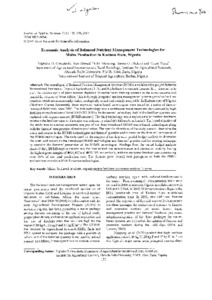| dc.contributor.author | Omadachi, U.O. |
| dc.contributor.author | Ahmed, B. |
| dc.contributor.author | Manyong, Victor M. |
| dc.contributor.author | Olukosi, J. |
| dc.contributor.author | Yusuf, O. |
| dc.date.accessioned | 2019-12-04T11:19:37Z |
| dc.date.available | 2019-12-04T11:19:37Z |
| dc.date.issued | 2007 |
| dc.identifier.citation | Omadachi, U.O., Ahmed, B., Manyong, V., Olukosi, J. & Yusuf, O. (2007). Economic analysis of balanced nutrient management technologies for maize production in Kaduna state, Nigeria. Journal of Applied Sciences, 7(1), 132-136. |
| dc.identifier.uri | https://hdl.handle.net/20.500.12478/3500 |
| dc.description.abstract | The overall goal of Balanced Nutrient Management Systems (BNMS) a collaborative project between International Institute of Tropical Agriculture (IITA) and Katholieke Universiteit Leuven (K.U. Leuven) is to curb the vicious cycle of plant nutrient depletion in maize-based farming systems in the moist savanna and humid forest zone of West Africa. This is through integrated nutrient management systems geared to land use practices which are economically viable, ecologically sound and socially acceptable. In Kaduna state of Nigeria (Northern Guinea Savannah), three improved maize-based technologies were tested in a series of farmer-managed field trials since 2000. The first technology was a continuous maize treatment characterized by high fertilizer rates (Sasakawa Global 2000 (SG 2000)). In the second technology, half of the fertilizer quantity was replaced with organic manure (BNMS-manure). The third technology was a soybean-maize rotation treatment in which the fertilizer rates to the maize was reduced by a half (BNMS-soybeanmaize). The broad objective of the study was to conduct economic analysis of the three introduced BNMS maize-based technologies along with the farmers’ own practice of maize production. The specific objectives of the study were to: determine the costs and returns to the BNMS technologies and farmers’ practice and to examine the farmers’ perception of the BNMS technologies. The tools used for the analysis of the data were: partial budget analysis to determine the costs and returns to the introduced BNMS technologies and farmers’ practice and the scoring technique to examine the farmers’ perception of the BNMS technologies. Findings from the partial budget analysis showed that, BNMS-soybeanmaize was the best in both the demonstration and adaptation trials by having the highest gross margins of 18,462 and 19,785, respectively, with the inorganic fertilizer cost constituting over 50% of the total production cost. The farmers gave overall best perception to both the BNM-soybeanmaize and the BNMS-manure technologies. |
| dc.language.iso | en |
| dc.subject | Balanced Nutrient Management Systems |
| dc.subject | Fertilizers |
| dc.subject | Technology |
| dc.subject | Maize |
| dc.subject | Economic Analysis |
| dc.title | Economic analysis of balanced nutrient management technologies for maize production in Kaduna state, Nigeria |
| dc.type | Journal Article |
| dc.description.version | Peer Review |
| cg.contributor.affiliation | Ahmadu Bello University |
| cg.contributor.affiliation | International Institute of Tropical Agriculture |
| cg.coverage.region | Africa |
| cg.coverage.region | West Africa |
| cg.coverage.country | Nigeria |
| cg.isijournal | ISI Journal |
| cg.authorship.types | CGIAR and developing country institute |
| cg.iitasubject | Nutrition |
| cg.iitasubject | Food Security |
| cg.iitasubject | Handling, Transport, Storage And Protection Of Agricultural Products |
| cg.iitasubject | Impact Assessment |
| cg.iitasubject | Livelihoods |
| cg.iitasubject | Soil Fertility |
| cg.iitasubject | Markets |
| cg.iitasubject | Baseline Survey |
| cg.iitasubject | Agribusiness |
| cg.iitasubject | Post-Harvesting Technology |
| cg.iitasubject | Maize |
| cg.iitasubject | Domestic Trade |
| cg.iitasubject | Integrated Soil Fertility Management |
| cg.accessibilitystatus | Limited Access |
| local.dspaceid | 95471 |
| cg.identifier.doi | https://doi.org/10.3923/jas.2007.132.136 |

